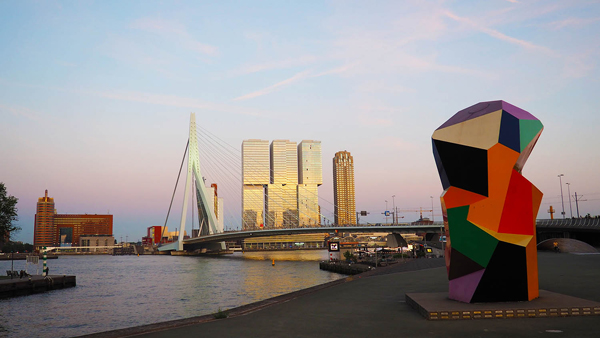A blog about (hidden) Amsterdam
A blog about (hidden) Amsterdam
Eighty years after the center of Rotterdam was destroyed, I walked through an empty Amsterdam. My city of too many visitors strolling along 17th-century canals while inhabitants whiz by on bikes seemed like an entirely different place without people. Just as pictures of Rotterdam before the bombing seem like another Dutch city, not the Rotterdam we know.
As a foreigner, I adore both cities, though true denizens of both would say that is impossible. Rotterdam is a young city with more people of different classes and different races. Amsterdam has citizens from 196 countries, but they are mostly marooned in smaller groups amidst of sea of tourists and white Dutch people whose forefathers built the canals and have the money to show for it. The difference between Rotterdam and Amsterdam is the difference between Kendrick Lamar and Billie Eilish; they are interesting in very different ways.

Like all local rivalries, the cities have more in common than they do differences. My university in Boston had a number of New York students who fought Massachusetts natives on principle. While studying abroad, both groups were flabbergasted that Europeans would mistake them for each other. Like New York and Boston, Amsterdam and Rotterdam attract a certain type of person and foster a different type. Rotterdam thinks Amsterdam is twee and unreal. Amsterdam, well, I don’t think Amsterdam thinks of Rotterdam much at all.
During the first months that COVID shutdowns emptied the city, however, this Amsterdammer thought a lot about the pictures of Rotterdam before and after the Luftwaffe hit it. Like Amsterdam, Rotterdam was a thriving port city clad in red brick and overseen by church spires. It was gone within a day. On the north side of the river, where the center of the town had been, only a church and a couple solid buildings survived. The pictures look like desolation.
Rotterdam now is a modern architecture showcase. It’s said that an architect hasn’t truly made it until they have a building in Rotterdam – and not just by the Dutch! After the war, the city rebuilt with care, attention, and lots of planning. Instead of recreating red brick history, they rebuilt with steel and glass ingenuity. The city is a marvel to look at from any angle. Clean and modern, it’s called the city of the future. The people get an energy from the buildings and they, in turn, funnel it into street culture and tech startups. It’s a special place.
No one would choose the tragedy that befell them. The injuries and deaths were appalling. As a lover of history, I mourn the destruction of the buildings and archives as well. But it is also undeniable that something impressive and unique was created on the foundation of that tragedy.
I tried, as I walked through Amsterdam’s deserted canal belt that day, to find some hope in Rotterdam’s fabulous skyline and culture. They would’ve given anything to avoid the times they lived through, as we would the crises we face today. But they took their loss and shaped it into something monumental. It gave me hope that we might do the same.
Check out some more Blamsterdam! posts.
Private Museum Tour
See the highlights and hidden icons of Amsterdam’s world-renowned Rijksmuseum in a private guided tour that explores who creates art and what stories it’s used to tell. And don’t worry about museum tickets. We’ve got you covered.


Small-Group Walking Tour
This historical tour through the busy Jewish quarter and residential Plantage neighborhood offers a selection of stories from BIPOC, LGBTQ+, Jewish and women’s history. It’s the perfect way to get an alternative view of Amsterdam.


Self-Guided Digital Tour
Use your phone to explore Amsterdam! This self-guided tour uses audio, images, maps, and text to introduce you to the women, BIPOC, LGBTQ+, and Jewish people who made Amsterdam what it is.


Small-Group Walking Tour
In 1593, Jewish Amsterdammers began building a community in the relative safety of the city that transformed both the Netherlands and the world. Learn about these creative, compassionate, and challenging mavericks and their impact.


Small-Group Walking Tour
The women who shaped Amsterdam are more complex than traditional tours would have you believe. Go to Amsterdam’s historic sites to hear stories of women who fought, wrote, calculated and led through the city’s chaotic and complicated past.


Small-Group Walking Tour
The world’s first gay marriage was officiated by the Mayor of Amsterdam at its City Hall. But did you know that the city’s LGBTQ+ history stretches centuries? Meet historical Amsterdammers across the gender spectrum and sexual orientations.


Private Walking Tour
Get a personalized tour that covers the interests you’re curious about and the neighborhoods you want to see. Choose pick-up/drop-off locations, any combination of our hidden history topics, and themes such as artists, politicians, and rebels.

